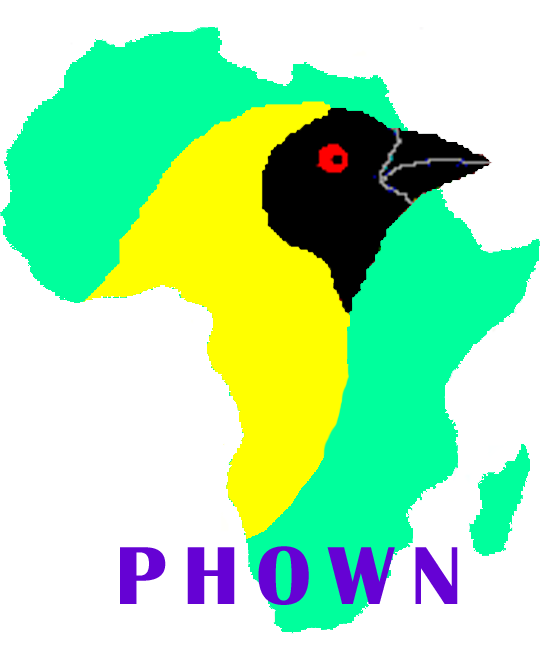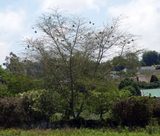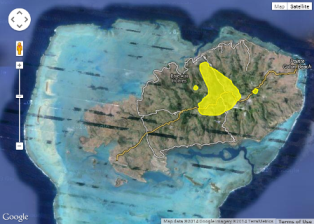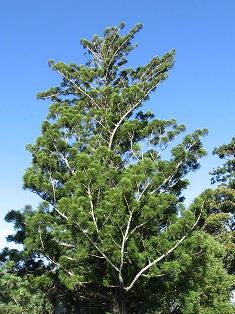Weaver species
Choose different species from drop-down list and press 'Go' button. See Full species list.Rodrigues Fody Foudia flavicans
IUCN: Vulnerable Discovery: 065Categories: island, Foudia, IUCN, nectar, blue eggs,
News items about species
Discovery
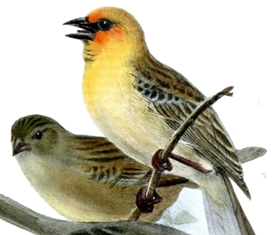
figure from Newton (1865) 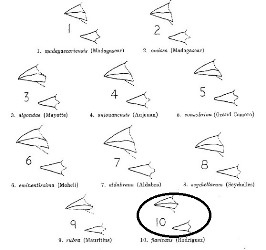
figure from Moreau (1960) 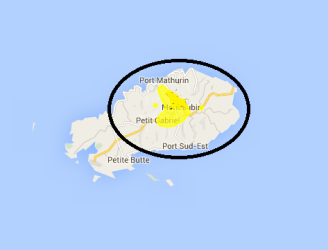
distribution, type locality circled IntroductionThe Rodrigues Fody was formally described by Alfred Newton, an English zoologist and ornithologist.The Rodrigues Fody had been collected by Edward Newton, the younger brother of Alfred, and a British colonial administrator and ornithologist. Alfred and Edward had obtained specimens of the Rodrigues Fody some 20 years earlier from John Augustus Lloyd, an English engineer and surveyor, who worked in Mauritius from 1831 - 1849. The Newton brothers thought the birds brought by Lloyd were flavistic Red Fodies. In November 1864, Edward visited Rodrigues Island and soon shot a Rodrigues Fody and recognised it as the same species as the Lloyd specimen. Edward noted that the species was very common, and he saw a flock of at least 100 birds. The first illustration of the Rodrigues Fody was of a male and female, published by Newton (1865). The next illustration pertaining to Rodrigues Fody was of the bill shapes of different fody species by Moreau (1960). Scientific citationFoudia flavicans Newton 1865 Proc. Zool. Soc. London, p.47 Rodriguez Island.Meaning of namesflavicans Modern Latin. flavicans, yellowish, golden-yellowish (L. flavus, golden-yellow, -icans, closely resembling).First English name"yellow bird" (Newton 1865), followed by goldfinch (Leguat 1891).Alternate namesRodriguez Fody, Yellow Fody.CollectorJohn Lloyd, and Edward Newton.Date collected1846 (Lloyd), and November 1864 and July 1865 (Newton).Locality collectedRodrigues Island.Type specimensThere are many syntype specimens in different museums, including Cambridge where Alfred Newton was based. |
The above is based on Weaver Wednesday 2, a weekly series about the discovery of each weaver species.
This species text first appeared as
Weaver Wednesday [182] - Discovery [65]: Rodrigues Fody on 2015-12-09
1. Basic biology

figure from Newton 1865 Distribution. The Rodrigues Fody has one of the smallest global ranges (5 km2) of any weaver. It is restricted to part of Rodrigues Island, Mauritius (see map below, based on Handbook of the Birds of the World, Vol. 15). There are no subspecies of the Rodrigues Fody. It is listed as VULNERABLE since it is restricted to a single island, on which it has a small population. Historically, it was abundant on the island, but was nearly driven to extinction with only 5 or 6 pairs remaining by 1968 after clearance of natural vegetation and cyclones. Due to conservation efforts its numbers are increasing, following an on-going programme of reforestation. The total population size in 2010 was estimated at 1700 individuals, but this is probably an under-estimate.
Habitat. The Rodrigues Fody inhabits remnant natural forest, and also exotic trees and shrubs where these are sufficiently dense. Food.
The Rodrigues Fody feeds mainly on insects (including caterpillars and homopteran bugs), spiders, seeds, nectar, and fruit. It has a brush-tipped tongue which is adapted to nectar-feeding. The Rodrigues Fody often forages by gleaning along branches and in the canopy. It is encountered in pairs or family parties, and occasionally in mixed-species flocks.
Breeding. The Rodrigues Fody is monogamous and breeds opportunistically. A pair defends its territory of 1000-4000 m2 throughout the year. The nest is oval, with a side entrance and short porch. The nest is roughly woven from grass, and feathers may be used as lining. The nest is placed 1.5-4.5 m above the ground at the end of a branch, most often in Araucaria cunninghamii trees. The same tree may be used as a nest site in successive years. The clutch is generally 3 eggs, which are pale blue. Incubation is by the female alone. Both parents usually feed the chicks and remove the faecal sacs. Chicks are fed by regurgitation or with live food. Nests are sometimes destroyed by children. |
The above is based on Weaver Wednesday, a weekly series about weaver species.
This species text first appeared as
Weaver Wednesday [87]: Rodrigues Fody on 2014-02-12
2. Breeding facts
| Pair bond Monogamous Breeding season Perhaps not seasonal, but opportunistic; records for Jul-Sept, Nov and Feb-Mar Nest site placed 1.5-4.5 m above ground at end of branch, most often of Araucaria tree Nest building in captivity male built basic nest frame, whereas field observations suggest that female builds nest Colony size No information Clutch size generally 3 eggs Egg colour pale blue Egg size average size ofseven eggs 18.3 x 13.6 mm Incubation incubation by female only, period 13-16 days in captivity Chicks and nestling period of two captive pairs, only female fed chicks at one nest, whereas at other both parents fed chicks and removed faecal sacs, live food carried in bill, chicks fed also by regurgitation, nestling period c. 14 days (both in field and in aviary); fledglings fed by both male and female |
Breeding information based on Handbook of the Birds of the World, Vol. 15.
3. Photos of Weaver Nests
 Vm 20938 |
Thumb-nails of most recent PHOWN records - click on one to see its full record
See all PHOWN records for this species here.
PHOWN (Photos of Weaver Nests) provides valuable info on breeding distribution and colony sizes of weavers.
You can contribute by registering and submitting photos at Virtual Museum webpage.
4. Breeding distribution
Google map showing distribution (For species with small ranges you need to zoom in at the correct area to see the range):
yellow blob - range of weaver species; read more about this here.
![]() - PHOWN records with photos
- PHOWN records with photos
![]() - PHOWN records with no photos (Nest Record Cards, other records)
- PHOWN records with no photos (Nest Record Cards, other records)
![]() - Birdpix records
- Birdpix records
![]() - comments on out of range records, or interesting records
- comments on out of range records, or interesting records
![]() - type locality
- type locality
CLICK on the marker on the map to see individual record details.
5. Range changes
Not South African speciesThe above is based on Weaver Wednesday 3, a weekly series about range changes in South African weaver species.
This species text first appeared as
n/a







